
How capillary action and the meniscus are related to intermolecular forces in water.
- Subject:
- Biology
- Life Science
- Material Type:
- Lesson
- Provider:
- Khan Academy
- Provider Set:
- Khan Academy
- Author:
- Sal Khan
- Date Added:
- 07/05/2015

How capillary action and the meniscus are related to intermolecular forces in water.
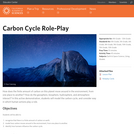
Students will learn that there is a finite amount of carbon on earth, which moves around in the environment, from one place to another. Activity is scaleable from elementary to high school with options to introduce advanced content. Wrap up includes role playing the carbon cycle with the addition of human influences (e.g. burning of fossil fuels). Activity can be done in classroom or outside, includes working in a group and role playing. Grades 3-12. This resources is part of the Our Changing Ocean and Estuaries Series

In this video segment adapted from NOVA, find out how cars made of a material stronger than steel and half the weight can help combat climate change.
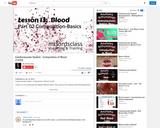
We take a look at the basic composition of blood. Blood is composed of liquids and solids. The solids are called the formed elements while the liquid portion is called plasma. The solids of the blood consists of red blood cells, white blood cells and platelets . The plasma is mostly water, but it does contain some plasma proteins, dissolved gases, nutrients and electrolytes.
Lesson 2 in our Cardiovascular System (Blood) series. This is part of our Anatomy and Physiology lecture series.
If this video helps you please be sure to LST -like subscribe and tell your friends. Your support helps us make more videos. For the complete series please visit http://mrfordsclass.net/
Blood Videos
-Introduction to Blood (13:01): http://youtu.be/-Y5U49E-CM4
-Composition of Blood (13:02): http://youtu.be/YHCIMKZ0zrg
-Hematopoiesis-Making Blood (13:03): http://youtu.be/sibrcrXHJGI
-Red Blood Cells (13:04): http://youtu.be/19_6kUCVYfk
Heart and Blood Vessels Videos
-Heart Fundamentals (14:01): http://youtu.be/Y335KJ-EuDw
-Layers of the Heart (14:02): http://youtu.be/8PlwFTwJRMQ
-Chambers in the Heart (14:03): http://youtu.be/SdNQtPzUfHg
-Introduction to Blood Vessels (14:08): http://youtu.be/GVs8cd6jv94
-Types of Blood Vessels (14:09): http://youtu.be/_jkQR8v-bAg
-Movement of Blood (14:11): http://youtu.be/x9dH5TpKntk
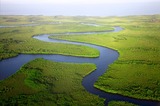
This lesson presents an overview of the careers available within Environmental Health.

In this activity, students consider how several communities are adapting to climate change-related problems including drought's impacts on agriculture, loss of assets due to climate-related hazards, freshwater availability, and extreme heat waves. They will read brief case studies about agro-forestry, insurance strategies, the "Room for the River" program in the Netherlands, water storage from retreating glaciers, and city planning for heat waves. Based on these examples and knowledge of their own community, they will suggest possible adaptation strategies that will be most beneficial to their area.
(Note: this resource was added to OER Commons as part of a batch upload of over 2,200 records. If you notice an issue with the quality of the metadata, please let us know by using the 'report' button and we will flag it for consideration.)
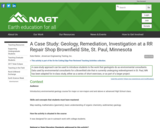
A case-study approach can be used to introduce students to the work that geologists do as environmental consultants. Data used by environmental consultants for a Brownfield site that is currently undergoing redevelopment in St. Paul, MN has been adapted for in-class study, either as a series of short exercises, or as part of a larger project.
(Note: this resource was added to OER Commons as part of a batch upload of over 2,200 records. If you notice an issue with the quality of the metadata, please let us know by using the 'report' button and we will flag it for consideration.)
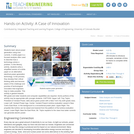
Students learn about power generation using river currents. A white paper is a focused analysis often used to describe how a technology solves a problem. In this literacy activity, students write a simplified version of a white paper on an alternative electrical power generation technology. In the process, they develop their critical thinking skills and become aware of the challenge and promise of technological innovation that engineers help to make possible. This activity is geared towards fifth grade and older students and computer capabilities are required. Some portions of the activity may be appropriate with younger students. CAPTION: Upper Left: Trey Taylor, President of Verdant Power, talks about green power with a New York City sixth-grade class. Lower Left: Verdant Power logo. Center: Verdant Power's turbine evaluation vessel in New York's East River. In the background is a conventional power plant. Upper Right: The propeller-like turbine can be raised and lowered from the platform of the turbine evaluation vessel. Lower Right: Near the East River, Mr. Taylor explains to the class how water currents can generate electric power.

Children get to know each other through an icebreaker activity that introduces the importance of water on Earth.

This interactive resource adapted from the National Park Service presents the key concepts of cave and karst systems, including how and where they form, different types, and various cave environments.
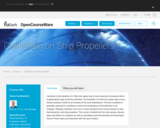
Summary: Cavitation is the transition of a fluid into vapour due to local reduction of pressure which is generated by high local flow velocities. The transition of a fluid into vapour also occurs during cooking of water by an increase of the local temperature. The term cavitation is generally reserved for conditions in which the temperature of the bulk fluid is not changed. Although cavitation can occur in many situations this course focuses on ship hydrodynamics and ship propellers. The course is divided into five main groups: physics, types and effects of cavitation as well as calculations and test facilities and techniques. Some of these topics are illustrated with the use of videos. (Study goals:) 1. Reproduce the main lines in a selection of the latest developments in the field of propulsion and resistance hydrodynamics, where the current selection of propulsion and resistance topics includes unsteady hydrodynamics of the flow over a foil, cavitation forms, problems and tools for analysis and design, propulsion systems in a service environment and ship drag reduction by air lubrication. 2. Analyse a hydrodynamic problem in the propulsion and resistance area, into well defined sub problems that can be analysed with state of the art knowledge and tools 3. Select the appropriate theory or tool (either numerical or experimental) for an analysis of the identified problem. 4. Reproduce and present to an audience, the main lines in a contemporary publication from the field of Propulsion and Resistance hydrodynamics. 5. Understand, interpret and react to questions from the audience and the lecturer and in doing so, stimulate the scientific debate.
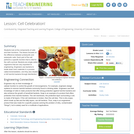
In this lesson, the students look at the components of cells and their functions. The lesson focuses on the difference between prokaryotic and eukaryotic cells. Each part of the cell performs a specific function that is vital for the cell's survival. Bacteria are single-celled organisms that are very important to engineers. Engineers can use bacteria to break down toxic materials in a process called bioremediation, and they can also kill or disable harmful bacteria through disinfection.
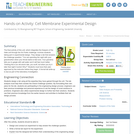
The final activity of this unit, which integrates the Keepers of the Gate unit through the Go Public challenge, involves students taking part in experimental design. They design a lab that answers the challenge question: "You are spending the night with your grandmother when your throat starts to feel sore. Your grandma tells you to gargle with salt water and it will feel much better. Thinking this is an old wive's tale, you scoff, but when you try it later that night it works! Why?" Students must have their plan approved by the instructor before they begin. A formal lab write-up is due as part of the laboratory investigation.
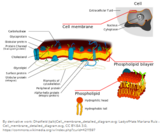
In this seminar you will create images of the biologically important structures of the cell membrane. The pictures will be translated to function. You will practice the terminology of these structures to associate their importance in the function of the cell membrane. The inquiry lab will allow you to design a model of the limitations of cell growth due to the cell membrane using water balloons.StandardsBIO.A.2.2.3 Compare and contrast the structure and function of carbohydrates, lipids, proteins, and nucleic acids in organisms.BIO.A.4.2.1 Explain how organisms maintain homeostasis (e.g., thermoregulation, water regulation, oxygen regulation).BIO.A.4.1.3 Describe how endoplasmic reticulum, Golgi apparatus, and other membrane-bound cellular organelles facilitate transport of materials within cells.BIO.A.4.1.2 Compare and contrast the mechanisms that transport materials across the plasma membrane (i.e., passive transport -- diffusion, osmosis, facilitated diffusion; active transport -- pumps, endocytosis, exocytosis).BIO.A.4.1.1 Describe how the structure of the plasma membrane allows it to function as a regulatory structure and/or protective barrier for a cell.
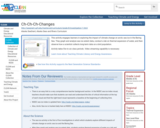
This activity engages learners in exploring the impact of climate change on arctic sea ice in the Bering Sea. They graph and analyze sea ice extent data, conduct a lab on thermal expansion of water, and then observe how a scientist collects long-term data on a bird population.
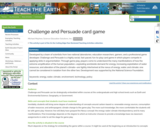
Developed by a team of scientists from two national laboratories, education researchers, gamers, and a professional game developer, Challenge and Persuade is a highly social, fast-paced, fun-to-play card game in which players compete in applying skills in argumentation. Through game play, players come to understand the many manifestations of how the extreme amplification of the human population, exploding worldwide demand for energy, increasing exploitation of water resources, and alteration of the planet's climateâare tightly intertwined at the nexus of energy, water, and climate; one cannot be considered in isolation from the other two. Development was supported by the National Science Foundation.
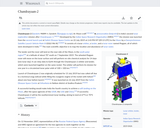
Chandrayaan-2 is India's second lunar exploration mission after Chandrayaan-1. It is developed by the Indian Space Research Organisation (ISRO), the mission was launched from the second launch pad at Satish Dhawan Space Centre on 22 July 2019 at 2.43 PM IST to the Moon .It consists of a lunar orbiter, a lander, and a lunar rover named Pragyan, all of which were developed in India.The main scientific objective is to map the location and abundance of lunar water.
It also has an objective of spotting soft land on lunar. Scientific goals include studies of lunar topography, mineralogy, elemental abundance, the lunar exosphere, and signatures of hydroxyl and water ice.

This activity requires construction of a simple salinity tester. Students will create their own calibration scale during this experiment, and look at the change in salinity that would arise if freshwater was suddenly dumped into the ocean. Materials needed for this investigation include a DC mill ampere meter, 2 D-cell batteries and holder, bronze sheeting, #18 solid wire, salt, deionized water, and a stream table or pan apparatus to create a hydrologic model of ice-ocean interaction. Included is a student worksheet to guide interpretation of data. The resource is supported by teacher background information, assessment suggestions, and a scoring rubric. This is Activity 3 of the learning module, Water: Here, There, and Everywhere, part of the lesson series, The Potential Consequences of Climate Variability and Change.

This resource is a video abstract of a research paper created by Research Square on behalf of its authors. It provides a synopsis that's easy to understand, and can be used to introduce the topics it covers to students, researchers, and the general public. The video's transcript is also provided in full, with a portion provided below for preview:
"Many factors affect the evolution of species, but a new influence has recently been recognized. Gut microbes – tiny residents of the intestinal tracts of all animals – have wide-ranging effects on the physiology of their hosts and scientists are increasingly appreciating that diversification may actually be correlated with changes in the gut microbiota. However, the extent to which gut microbes evolve along with a host species remains unclear. A recent study examined this correlation using an ideal model – a system where evolution repeated itself in different geographic settings. Beginning with two groups of Nicaraguan cichlid fish that evolved in parallel in different crater lakes researchers sequenced microbes from fish guts and lake water to determine whether species diverged in parallel. They found that bacterial communities in fish were distinct from those in lake water..."
The rest of the transcript, along with a link to the research itself, is available on the resource itself.

In this video adapted from the Arctic Athabaskan Council, learn how warmer temperatures in the Arctic are transforming the landscape, triggering a host of effects such as permafrost thawing and insect infestations.